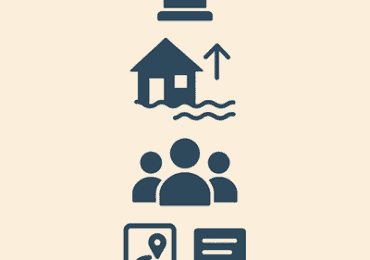Table of Contents:
- Introduction to Community Preparedness
- The Importance of Early Warning Systems
- Building Safe Shelters and Evacuation Routes
- Community Emergency Response Teams (CERTs)
- The Role of Technology in Storm Preparedness
- Financial Preparedness and Insurance
- Collaborative Efforts for Recovery
- Real-Life Examples of Successful Community Preparedness
Introduction to Community Preparedness
Unpreparedness can result in devastating consequences when it comes to natural disasters. Communities that invest in preparedness can significantly mitigate the impacts of storms. It involves a comprehensive plan that protects both lives and infrastructure. As the frequency and intensity of storms increase, the role of effective storm response & emergency restoration cannot be overstated. Such services ensure communities have prompt action plans to handle and recover from unexpected challenges. Preparing for severe weather events includes understanding local vulnerabilities and strengthening areas where possible. Initially, it might seem daunting, but with a strategic approach focusing on community-wide initiatives, the long-term benefits are profound. Communities that effectively prepare protect themselves and set an example for others, proving that significant challenges can be overcome with foresight and collective effort.

The Importance of Early Warning Systems
Robust early warning systems greatly enhance the effectiveness of any preparedness plan. These systems provide crucial alerts and forecasts that inform necessary actions before a storm hits. Such alerts can be lifesaving, allowing people to secure their homes and head to safety. The dependability and precision of these systems are essential to community safety, ensuring that individuals can evacuate non-dependent areas and safeguard crucial resources.
Moreover, technological advancements have increased the scope and reach of these warning systems. Integrations with mobile technology mean that alerts can be tailored and immediate, reaching people wherever they are. This technological edge increases a community’s safety and awareness levels and fosters a culture of proactive disaster management.
Building Safe Shelters and Evacuation Routes
Safe shelters are the cornerstone of storm preparedness. These shelters should be strategically located to provide convenient access for vulnerable populations. Designing them to withstand severe weather ensures they remain operable and safe during crises. Additionally, their availability must be communicated to all community members well before impending storms so everyone knows where and how to reach safety. Equally important are mapped evacuation routes. These routes must be kept clear and navigable at all times, with signage that is easy to follow during potentially chaotic situations. Regular drills and community briefings can ensure people are familiar with these routes and confident in their evacuation plans. Such exercises are crucial as they significantly reduce panic and confusion during an emergency, allowing for a smoother transition to safety.
Community Emergency Response Teams (CERTs)
Community Emergency Response Teams (CERTs) are invaluable storm preparedness and response assets. Comprised of trained local volunteers, CERTs provide immediate assistance in the initial aftermath of a storm. Their training typically covers essential skills such as basic medical operations, fire safety, and light search and rescue. By having these teams in place, communities can effectively manage immediate needs while waiting for professional responders to arrive. Beyond emergency management, CERTs also play a vital role in prevention and education, conducting community training sessions and simulations to prepare residents for storms better. These initiatives build a sense of ownership and responsibility within the community, enhancing overall preparedness and resilience against future storms.
The Role of Technology in Storm Preparedness
Technology has revolutionized how communities prepare for storms. Today, mobile applications and social media platforms can provide up-to-the-minute updates and practical guidance on weather conditions, emergency protocols, and resource availability. This instant access to information keeps communities agile, encouraging timely actions and informed decision-making.
Moreover, technology facilitates better communication between emergency response units and agencies. It enables real-time coordination, fostering a unified response strategy that maximizes available resources and minimizes risks. Communities leveraging advanced technology in their preparedness plans can anticipate better outcomes, minimizing disruptions and accelerating recovery efforts post-storm.
Financial Preparedness and Insurance
Financial preparedness is a critical yet often overlooked aspect of storm readiness. The right insurance policies are paramount to covering potential storm and flood damages. Property owners should review their insurance plans regularly to ensure they have the appropriate coverage for their needs. Beyond insurance, creating a detailed financial emergency plan can make a world of difference in the recovery phase. It includes setting aside specific funds for unforeseen events and planning to access financial records and vital documents quickly should evacuation become necessary. Financial security offers a sense of stability to affected individuals, enabling them to focus on recovery and rebuilding efforts without the added burden of economic stress.
Collaborative Efforts for Recovery
Local governments, businesses, non-profits, and residents all have roles to play in ensuring that recovery efforts are comprehensive and inclusive. By sharing resources, knowledge, and skills, communities can more effectively address the many challenges a storm recovery presents. Communities that have thrived post-disaster often cite collaboration as a key factor in their success. By fostering environments where collaboration is the norm, these communities recover faster and build stronger, more resilient infrastructures that safeguard against future storms. Such collaborative frameworks should be a central element in any preparedness plan, ensuring a unified and coordinated response.
Real-Life Examples of Successful Community Preparedness
Various case studies around the globe demonstrate the effectiveness of community preparedness plans. For instance, communities in hurricane-prone areas like Florida have made significant strides in storm preparedness through comprehensive planning, enhancing their resilience with each passing season. Learning from these real-life examples is invaluable. They highlight what has worked, what hasn’t, and what other communities can do to improve their strategies. Such insights are crucial for individuals and planners alike, enabling them to refine their approach and ensure their communities are as prepared as possible for future storm challenges.